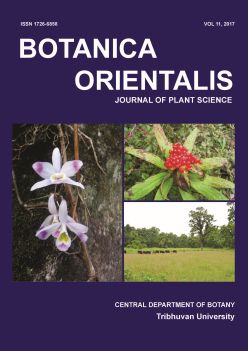Trade and conservation of medicinal and aromatic plants in western Nepal
DOI:
https://doi.org/10.3126/botor.v11i0.21029Keywords:
Baitadi, Harvesters, Income, MAP trade, Paris polyphylla, Traders, WholesalersAbstract
This paper quantifies the volume and value of medicinal and aromatic plants (MAPs) traded from Baitadi district in western Nepal. Information related to trade, in the Fiscal Year 2014/015, was collected through pre-tested structured questionnaire. Harvesters (n = 24) and the entire population of sub-local (n = 35) and local (n = 7) traders were interviewed to quantify the value and volume of MAP trade from the district. Results showed that 15.2% households were engaged in harvesting of MAPs for trade, contributing 9.5% of the total cash income giving an impression that MAPs provide supplementary source of income. A total of 731.5 tons of MAPs, comprising 17 products (from 17 species) with total value of NRs 31.3 million (US$ 315,175) was traded from the district. Rittha (Sapindus mukorossi), tejpat (Cinnamomum tamala) and pakhanved (Bergenia ciliata) were traded in higher amounts, representing 356.5, 171.0 and 70.0 tons, respectively. The cumulative value of trade was highest for satuwa (Paris polyphylla) with NRs 7.7 million. Nepalgunj is the favoured ‘transit’ city for the export of MAPs to India accounting for more than 82% of MAPs sourced from Baitadi. Satuwa has been identified as the most vulnerable species mainly due to premature and over-harvesting in response to high price and growing regional demand coupled with slow growth and high habitat specificity that may results in impaired population growth, thus demanding a detailed bio-physical studies. The study finds that strict regulatory mechanism like ban proves to be less effective in species conservation and suggest adopting alternative management strategies.
Botanica Orientalis – Journal of Plant Science (2017) 11: 27–37
Downloads
Downloads
Published
How to Cite
Issue
Section
License
This license enables reusers to copy and distribute the material in any medium or format in unadapted form only, for noncommercial purposes only, and only so long as attribution is given to the creator.




